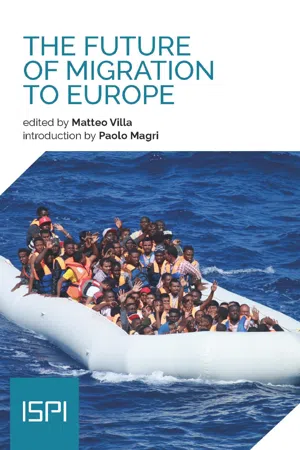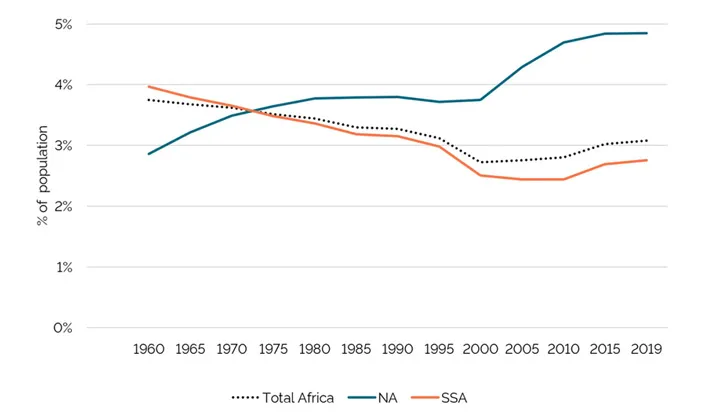
- 157 pages
- English
- ePUB (mobile friendly)
- Available on iOS & Android
eBook - ePub
The Future of Migration to Europe
About this book
Even as the 2013-2017 "migration crisis" is increasingly in the past, EU countries still struggle to come up with alternative solutions to foster safe, orderly, and regular migration pathways, Europeans continue to look in the rear-view mirror.This Report is an attempt to reverse the perspective, by taking a glimpse into the future of migration to Europe. What are the structural trends underlying migration flows to Europe, and how are they going to change over the next two decades? How does migration interact with specific policy fields, such as development, border management, and integration? And what are the policies and best practicies to manage migration in a more coherent and evidence-based way?
Frequently asked questions
Yes, you can cancel anytime from the Subscription tab in your account settings on the Perlego website. Your subscription will stay active until the end of your current billing period. Learn how to cancel your subscription.
No, books cannot be downloaded as external files, such as PDFs, for use outside of Perlego. However, you can download books within the Perlego app for offline reading on mobile or tablet. Learn more here.
Perlego offers two plans: Essential and Complete
- Essential is ideal for learners and professionals who enjoy exploring a wide range of subjects. Access the Essential Library with 800,000+ trusted titles and best-sellers across business, personal growth, and the humanities. Includes unlimited reading time and Standard Read Aloud voice.
- Complete: Perfect for advanced learners and researchers needing full, unrestricted access. Unlock 1.4M+ books across hundreds of subjects, including academic and specialized titles. The Complete Plan also includes advanced features like Premium Read Aloud and Research Assistant.
We are an online textbook subscription service, where you can get access to an entire online library for less than the price of a single book per month. With over 1 million books across 1000+ topics, we’ve got you covered! Learn more here.
Look out for the read-aloud symbol on your next book to see if you can listen to it. The read-aloud tool reads text aloud for you, highlighting the text as it is being read. You can pause it, speed it up and slow it down. Learn more here.
Yes! You can use the Perlego app on both iOS or Android devices to read anytime, anywhere — even offline. Perfect for commutes or when you’re on the go.
Please note we cannot support devices running on iOS 13 and Android 7 or earlier. Learn more about using the app.
Please note we cannot support devices running on iOS 13 and Android 7 or earlier. Learn more about using the app.
Yes, you can access The Future of Migration to Europe by matteo villa in PDF and/or ePUB format, as well as other popular books in Social Sciences & Emigration & Immigration. We have over one million books available in our catalogue for you to explore.
Information
1. What the Future Holds: Migration from Africa to the EU
Matteo Villa, Elena Corradi
Over the last few years, in Europe the word “migration” has often gone hand in hand with the word “crisis”, as irregular flows to the European Union reached unprecedented levels between 2014 and 2018. Public opinion and policy makers’ attention has dwelled on existing difficulties and immediate responses. The EU-Turkey statement in March 2016, and agreements with transit countries in Africa (Niger, Ethiopia, and Libya) are examples of this short-term approach. Indeed, attempts at “externalising” border control have been successful at bringing down irregular arrivals to Europe: in 2016, arrivals to Greece shrank by 98%, and since mid-2017 arrivals to Italy have followed the same pattern (-93%). Evidence however shows that, while potentially effective1, restrictive migration policies cannot stop migration altogether2. This means that, even as the European “migration crisis” is now over, its conclusion will not mark the end of irregular immigration to the EU. Long-term responses are therefore sorely needed.
At the same time, the belief that migration to the EU will rise uncontrollably in the near future seems to be gaining traction. Recently updated UN projections show that the African population is meant to double between 2010 and 2040, from 1 to 2 billion people (i.e., four times the population of the EU28). These projections have fuelled fears of a potential “multiplier effect” that demographic growth could have on migration from Africa to Europe3. In this chapter, we set out to investigate whether these fears are grounded. We attempt to leverage data on half a century of migration from Africa to Europe to forecast what could happen in the future. We do so as we believe that an evidence-based projection of likely migration trends should be used to prepare for what the future holds, and to better inform planning and policy design in the EU and its Member States.
Like any forecasting exercise, this is no easy task. Forecasting future differences in migration stocks is particularly difficult as migration is conceptualised differently across countries, with data often incomplete and problematic. Furthermore, it is difficult to capture a comprehensive picture of all migration drivers4. Most demographic forecasting attempts thus treat migration as impossible to predict and, therefore, rely on scenarios that assume migration settles at some constant level compared to historical trends5. Of course, conflict-related migration and other forced movements are hardest to predict, and may warrant such a treatment. However, structural factors could help us predict the intensity, direction, and timing of other migration movements.
In this chapter we delve deeper into a specific subset of migration flows, namely net emigration from African countries to the EU. By analyzing past trends, we find that many of the correlates that appear to drive bilateral migration at the global level do not seem to apply in this case. Instead of representing a problem, we turn the problem on its head, and attempt to forecast future flows directly. In an effort to be as fine-grained as possible, we provide country-specific forecasts of net emigration to the EU from 56 African countries and other territories identified by United Nations Department of Economic and Social Affairs (UN DESA) between 2020 and 2040.
We find that while future migration from the African continent to Europe should remain robust, it is not expected to reach unprecedented levels even as the African population doubles. What is more, African migration to the EU is not even expected to rise linearly in tandem with the growth of African population, but to rather settle to pretty stable levels.
Our forecasts show that while migration from Africa to Europe will continue to pose a challenge to EU policy makers, this will not be an unprecedented challenge. As such, it will be crucial to prepare for potentially robust migration flows from the African continent, but this is a challenge that the EU as a whole can certainly manage.
Historical Trends of African Migration to Europe
In order to forecast future migration trends from Africa, we first need to understand what they look like today and how they have evolved in the recent past. To do so, we combine data on decadal migrant stocks between 1960 and 2000 from the World Bank6 with data on five-year migrant stocks between 1990 and 2019 from the UN7. For the time span where they overlap, the two datasets do not report the same levels of migrant stocks. We merge them by calculating a country-specific multiplier that we then use to fit World Bank (WB) data to the UN’s. We calculate this multiplier as the ratio of migrant stocks reported by the UN in 1990 to the migrant stocks reported by the WB in the same year, for each African country. Finally, given that WB data is decadal, while UN data is provided on a five-year basis, we interpolate stock and population data for the years 1965, 1975 and 1985.
Today around 3.1% of Africans live abroad, compared to a world average of 3.5% international migrants per inhabitant. This share stands out as even smaller if compared with Europe, which is the first region in terms of how many of its citizens live abroad compared to its own population, with 8.2% of its population living outside their country of birth, and Latin America, where 6.2% of the population has crossed an international border and now lives abroad.
Figure 1.1 shows Africa’s international migrant stock as a share of the continent’s population, as it varies with time (dotted line). If we separate sub-Saharan African (SSA) migrants from Northern African (NA) migrants, we notice that up to very recently the share of population living outside their country of birth followed two opposite trends8. Before 1970-1980, the share of sub-Saharan Africans abroad was actually greater than that of North Africans. However, over the years, whilst an increasing percentage of Northern Africans migrated, the share of SSA migrants slowly decreased and came to a stall. Since 2010, this trend reverted, but there still remains a substantial difference between the percentage of NA and SSA migrants, as today the share of Northern Africans abroad is almost double that of sub-Saharan Africans.
Fig. 1.1 - Stock of African emigrants /
total population of origin
total population of origin

Source: authors’ elaborations on UN DESA and WB data
We now turn to African migration to the EU. To frame this focus, we take a step back to the 3.1% of Africans who have migrated and consider that approximately half of them have left the continent. Of those who have left the region, an even smaller percentage has reached the European Union: overall, today, only 26% of all African migrants are in the EU.
Even so, as Figure 1.2 shows, the stock of African migrants living in the EU in 2019 is almost ten times the stock of migrants sixty years ago, in 1960. If we look back at the last thirty years, between 1990 and 2019, the number of African migrants in the EU has more than doubled, from 4.6 million to 10.3 million. This increase concerns both migrants from SSA and those from NA countries. Given NA’s geographical proximity to EU countries, however, the share of migrants from this area living in the EU has constantly been higher than the share of SSA migrants. However, while in 1960 SSA migrants made up only 22% of all Africans living in the EU; this share has slowly increased over time, reaching 36% in 1990 and 46% in 2019.
Notwithstanding the latest 2013-2017 “migration crisis”, Africans living in the EU still comprise only 2.0% of the bloc’s overall population. This share has indeed doubled from 1.0% in 1990, but mostly between the late 1990s and early 2000s, not ...
Table of contents
- Cover
- The Future of Migration in Europe
- Colophon
- Table of Contents
- Introduction
- 1. What the Future Holds: Migration from Africa to the EU
- 2. Migration, Development and the 2030 Agenda
- 3. The Future of Legal Migration
- 4. Safe and Legal Pathways for Refugees
- 5. The Future of Irregular Migration to Europe
- 6. The Future of Integration: New Technologies for a Migrant-Centric Approach
- The Authors